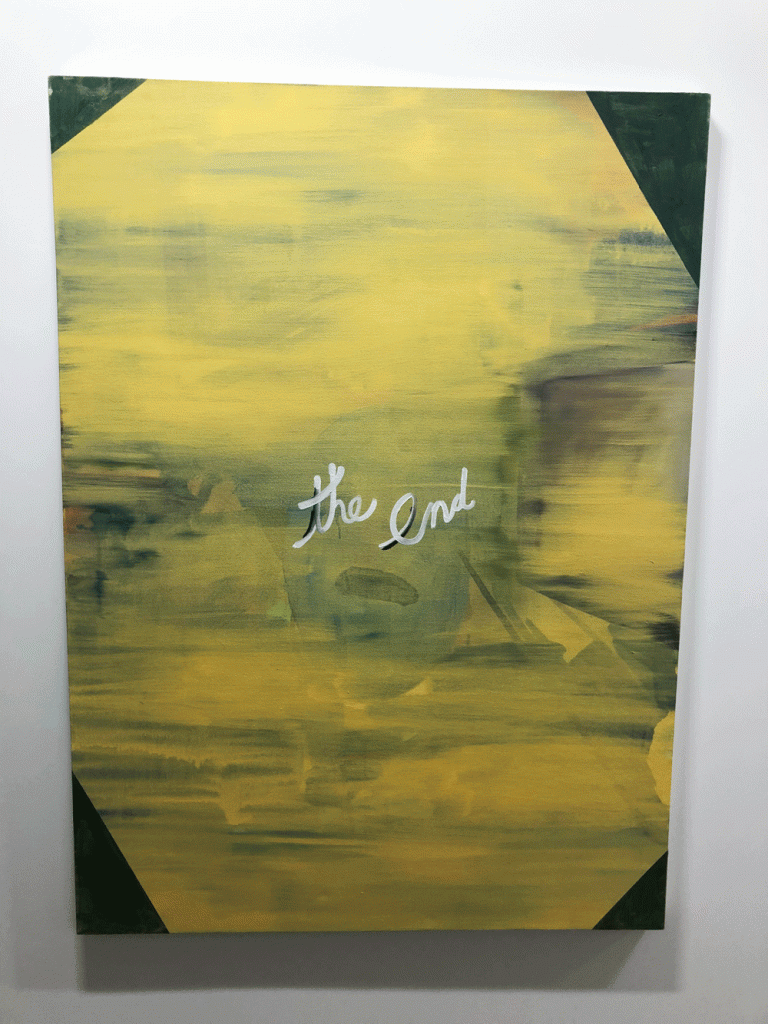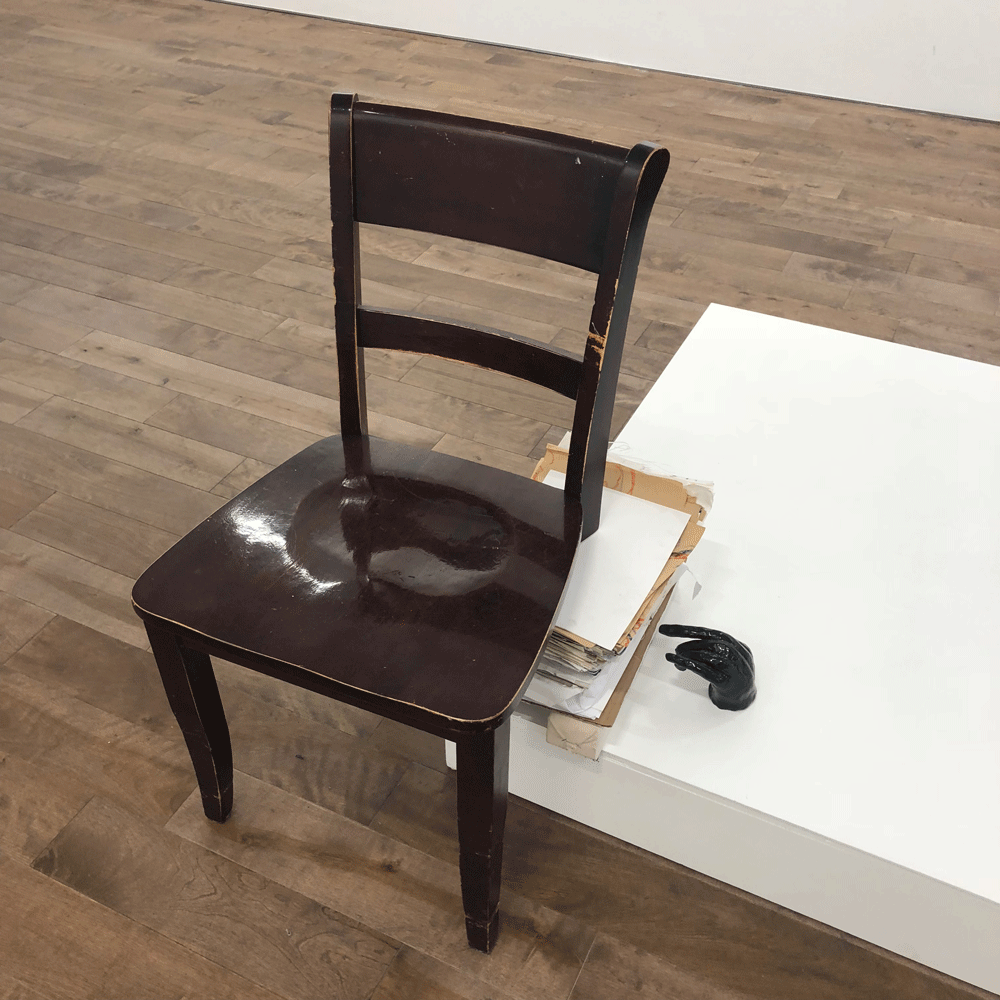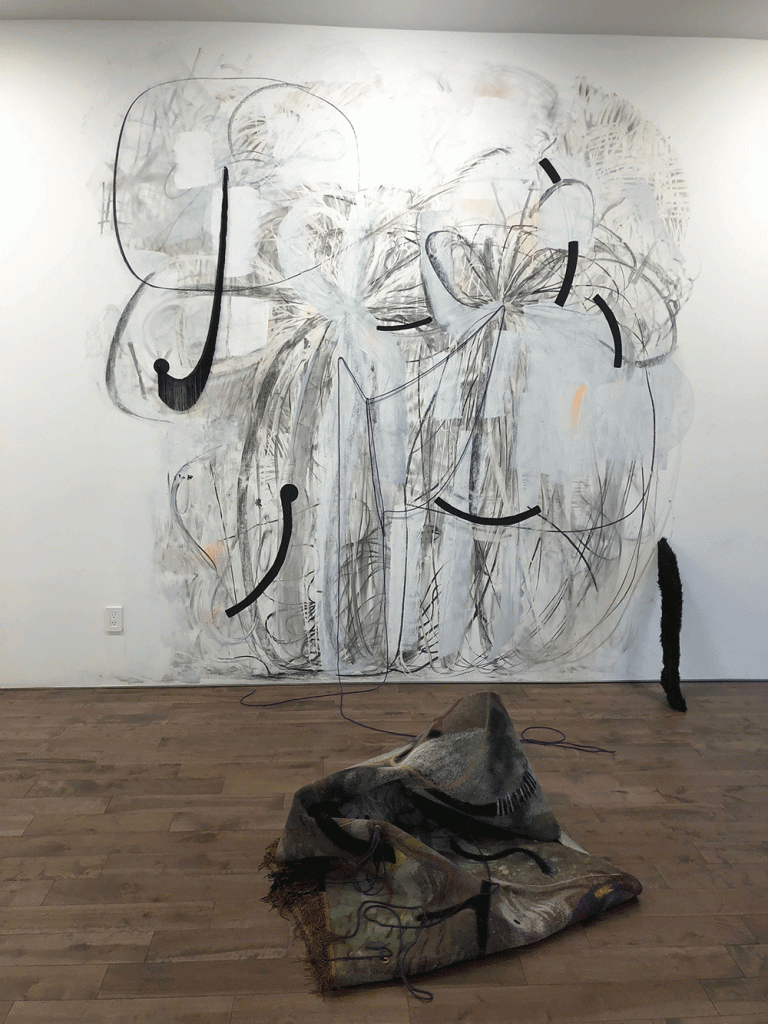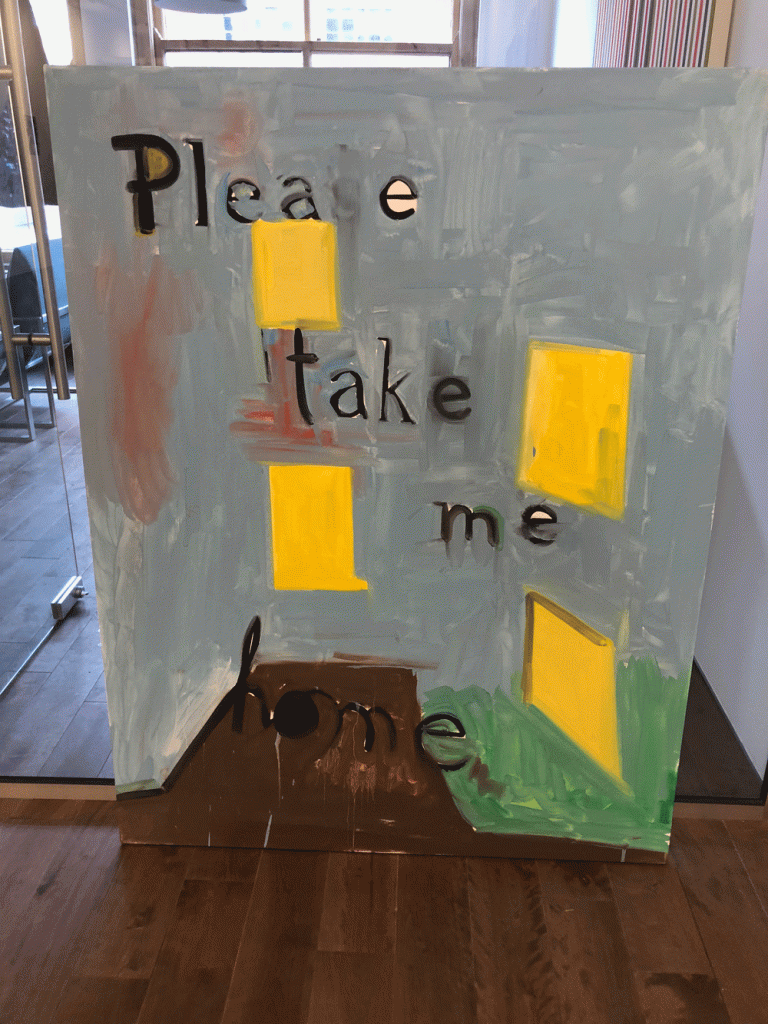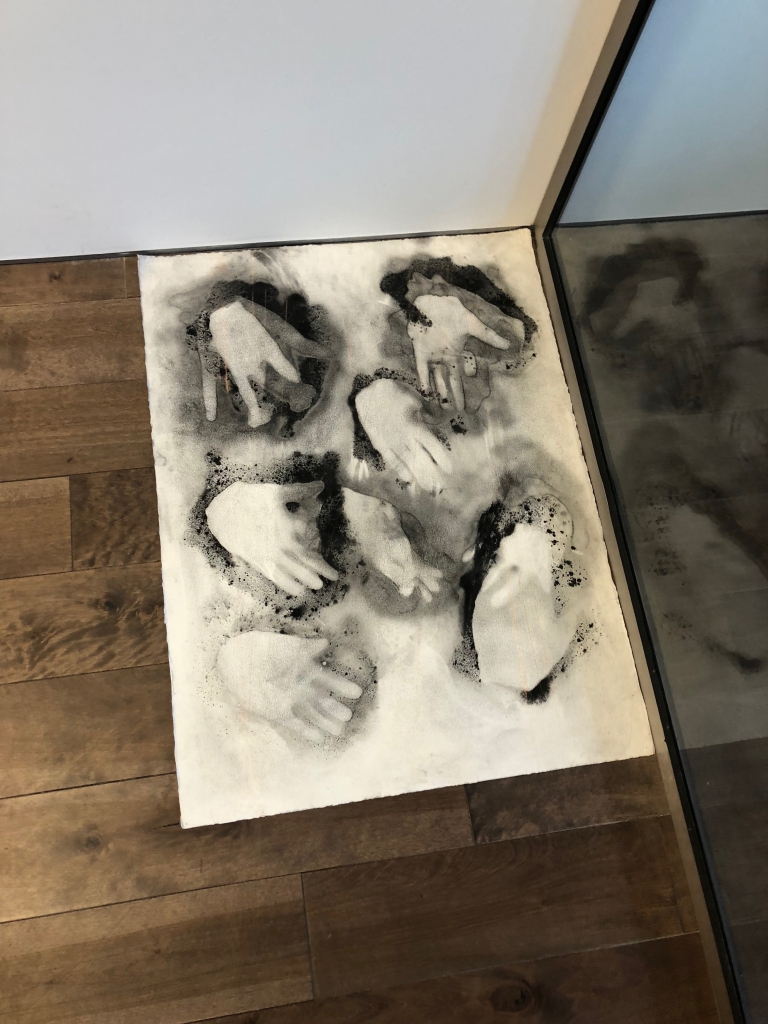The post Fait ou défait, c’est idem first appeared on The Belgo Report.
]]>Fait ou défait, c’est idem
Galerie Deux Poissons
July 12-August 25, 2018
What I found most striking about Fait ou défait, c’est idem, Galerie Deux Poisson’s fourth show, was how collaborative it was, how well the works of these four artists worked in a sort of humble synergy that was at once nameless and named. The show was curated by artist and writer Benjamin Klein, and the curation was strong in this group show; I find group exhibitions are exceedingly hard to pull off, as they too often seem forced, like a gaggle of people compelled to hang out awkwardly. Either they don’t seem to relate at all or they are gathered simply by common theme or medium, having nothing else to bind them together. In this exhibition, however, that was not the case. It had a real grassroots feeling, a sense of true collaboration and excitement. I am going to refrain from describing each work individually; the spirit of this exhibition is the sense of unity and togetherness that makes all the pieces work as a whole.
Fait ou défait, c’est idem, translated as “done or undone is the same”, alludes to the process of art-making. How does one know when a piece is completed? Is it ever truly done? An artist can stop working at any point and call it finished, no one can ever truly know when a piece is completed, including, oftentimes, the artist. It becomes a choice, an intuition, or it could come with being fed up or having a deadline. The word faire in French means both “to do” and “to make”, so, evocatively, the show’s title could also declare, “made or unmade, it’s the same.” One’s making and one’s doing carry the seed in the same word, as well as its opposite, as from the moment we are born—or made— we start dying.
The first thing one would encounter when entering the gallery is, ironically, a painting by Malcolm McCormick entitled, The End. It’s roughly but tenderly composed, with black “photo corners” and white script declaring “The End” in the middle. It is plaintive, mock sentimental and also cute. Smears of mustard-paint allow one to see the underpainting as if through a screen.
If one doesn’t strictly make the rounds, the visitor would likely then notice the impressive installations at the room’s centre. On the floor is a piano-shaped wood and cloth structure titled The Sparrow on the Hill Sees the Fool Going Around by Malcolm McCormick, a painter who also works with drawing and installations. Inside are works on paper by Mathieu Lacroix and Rachel Crummey, and ceramic hands by Michelle Furlong, along with found objects. There is a play on collaboration here, music is more frequently made in a group, multiple instruments and players create greater complexity than one individual is capable of.
Behind this piece, on a white block rests a piece by Lacroix, another legless piece—do we have a leg to stand on without our friends and collaborators?—is a three-legged chair propped up by stacks of papers and drawings, with a ceramic hand by Michelle Furlong pointing to a spot in the stacks. After this, certainly one could not help but be drawn to the immense in situ mixed media wall piece and installation by Rachel Crummey and Michelle Furlong towards the back of the gallery, titled Experience no. 2, after a piece by John Cage. Layered with bold and gestural marks in charcoal, graphite powder, acrylic paint and spray paint, the eye follows the energy of two artists and one can’t help but visualize their process, working together, erasing the work of the other, wondering if they worked in harmony or at times, adversarily. I think of how Robert Rauschenberg came to de Kooning to ask him if he could erase one of his drawings, which was allowed. Klein told me that he witnessed the process, allowing the artists to work uninterrupted, and saw how many times it could be completed, yet a new movement and shift began. It seemed a process fraught with dynamism and energy. The piece is so energetic that it cannot be contained to the wall.
A large piece of cheap-looking wall-to-wall carpet was contorted on the floor and subjected to the treatment of paint, recalling Furlong’s crumpled painted canvases. Most of the works in this show walk a thin line between ugliness and beauty, humility and humour. A leg made of black faux fur projects from the wall, reminding me of Dada creations. The piece sports rope of a gaudy purple shade, connecting the wall to the folds of carpet like an umbilical cord, its colour standing in stark contrast to the rest of the piece’s monochrome.
A painted disc of carpet stands alone like punctation on the floor, and large strips of black velcro and fringe with what appear to be large black pasties could suggest a crude face. The sort of feminine grunge aesthetic of Crummey and the slick, cool aesthetic of Furlong make an uneasy but pleasing contrast which gives the work a sort of personhood, even beastiness. I imagined it being made with John Cage playing in the background, the artist’s gestures and erasures moving to the sound like the surges of a symphony.
Scattered throughout the exhibition are Michele Furlong’s shiny, black-glazed ceramic hands pointing, squatting and hiding. They made me think of Thing in the Addam’s family, and their ubiquitousness felt as if they were the same hand, everywhere. They seemed at times to be the hand of the curator, invisibly and gentling guiding your attention.
Rachel Crummey is an award-winning Toronto-based abstract artist (and writer) working with painting, drawing and installation. Her work is layered, rich, and informed. She is an emerging artist who received her MFA from the University of Guelph in 2014. Her work is most successful in series, and this exhibition has a few of her works on paper, oil pastels on paper and acrylic on board or canvas. Her play of lines and layering is often very graceful. As in Experience no. 2, her installations in charcoal and graphite look like traces left by a ghost or the residue of a spirit or slug, but it could also be a kind of unusual wallpaper, worn with time and peeled away in strips. Her small works in this show are subtle in comparison to the collaborative installation, and quite accurately she describes her work as a “softly moving web.” One of her most engaging pieces here is a network or lung of actively tangled blue lines, made from oil pastel on paper. Much of her work is very tender and touching, and improvisation plays a strong role in her practise.
Malcolm McCormick is a primarily a painter (and drawer) but is also a multi-disciplinary artist. He’s from Vancouver and came to Montreal as an MFA candidate at Concordia. He’s spoken of being interested in colour, the formal aspects of making, collage-style work and things that are non-monumental and subtle. His work is sometimes wryly humorous and it has a sensitive yet painterly touch.
Besides The End, another funny piece sits on the floor saying: Take Me Home. Another work is an invisible house where all you can see are illuminated windows and a hastily painted, blue-steel background with brown ground and green grass, uneven letters imploring the viewer. Does the artist wish to go home, or the painting? Every painting for sale in fact says this wordlessly, and it was charming to have it so imploringly stated as it wasn’t even hung. His other oil painting, Banging Your Head Against a Warm Rock was textured with pebbles and almonds. Overall, McCormick’s work is deceptively simple, endearingly unostentatious, but skillfully handled and exploratory. McCormick said in an interview for his Kelowna Art Gallery duo exhibition in 2017: “ I like to make things that show an accumulation of decisions, and to leave traces of each decision so that the viewer can come into it and get a sense of how this thing developed over time”. The poetically titled, “Looking into His Ear” is a painting layered with transparent polkadot fabric, which leads one to visualize the layers and channels of the body and the delicacy of listening and looking.
Michelle Furlong is a Montreal-based multi-media artist, a recent graduate of Concordia’s Painting and Drawing program. Her work frequently consists of cutouts, textiles, texture, silhouettes, sharp contrasts, soft forms, stylized shapes and often, a cold, almost graphic, design. working primarily in paint, drawing and sculpture. Her work is largely concerned with the body, and hands are a major player. Her drawing sits on the floor in the corner, and is layered with outlines of hands, much as a child would use their own body as a starting point for making shapes and forms, and paint with their fingers. The effect of the ghost-like hands layered in blacks and whites and layers of charcoal, using negative space, and tucked away on the floor is at once haunting, playful, and evocative. There is a sense of ephemerality and whimsy, an awareness of temporality, of the limitations to the corporeal form in Furlong’s work. The hands play throughout the gallery, dark and shiny, slick, but not sinister.
Mathieu Lacroix is a Montreal native and multidisciplinary artist who received his BFA at UQAM. His grid of drawings here are reminiscent of architectural drawings, but also de Chirico. Some are on vellum, some on brown packing paper. There are elements of collage, and they are all cleverly composed, contemporarily-aware works that aren’t precious at all, which is why, I suspect, he titles all of these works NON ART. They fit perfectly with the drawing theme of the exhibition and the sense that creativity will continue and art will be made regardless of the means at one’s disposal. These are unpretentious drawings, and, despite being a rather conceptual show, Fait ou défait, c’est idem is also quite unpretentious and certainly process-oriented. Lacroix’s drawings contain a sense of resilience in their delicacy. His work uses reclaimed and recycled materials such as cardboard, ordinary, cheap substances. Art can and will continue without expensive materials and resources that often make it the domain of the privileged. Lacroix’s playful sculpture, NON ART: Chair, calls to mind the absurdity of Dada, a three-legged chair. Is it a comment on academia? The third leg is made of theory, of drawings, of studies. All of his works in this show are labeled emphatically NON ART, and then given a secondary title, in this case, NON ART: Chair. As an artist he to seek to connect to the ordinary and mundane through his subject and media, then thwart our expectations. These drawings engage with formal abstraction and imaginary space. We see a square building with grass growing out of its centre, long black hair pouring down like a waterfall; we see what may be a railroad station with water emerging through it being transformed in shape by its passage through the building, the rails of which pour with light, a power station, an A frame building overruled by a flow chart, a collision of realities and geometries, an unusual combination of formal fascination and dreamy imagination. They could be diagrams made on acid or instructions for or by aliens for human society.
The works here as a group, and even individually, don’t say “I, I” they say “us, we”. There is a particularly Montrealaise spirit here, a sort of “struggling artist”, communal sensibility of resourcefulness, resilience and joie de vivre. There is strong sense of line, of hesitant but necessary declaration and bold erasure. The marks made by the individual on the world, the lines that tie us together. The connections. The overlap, the influence. The give and take. This exciting and ground-breaking exhibition is a sign of innovative work both in artistic production, support for emerging artists and dynamic curation taking place at Galerie Deux Poissons and bodes well for future developments. Galerie Deux Poissons is a blessing for the artistic community of Montreal for its role in maintaining the importance of the Belgo Building as a Montreal landmark which has recently lost some important galleries.
The post Fait ou défait, c’est idem first appeared on The Belgo Report.
]]>The post Benjamin Klein: Tenir les Murs first appeared on The Belgo Report.
]]>Tenir des Murs: Exhibition
Joyce Yahouda Gallery
July 22-August 6
Tenir des Murs was a group exhibition at Joyce Yahouda Gallery, literally translated as “to hold up the wallsâ€, a French expression meaning “hang aroundâ€. The paintings in the group exhibition were placed on the floor, in effect holding up the walls, allowing a different vantage point from which to view them. I found it a refreshingly casual approach, giving the experience the feel of a studio visit, allowing the viewer to hang around the artwork and indulge in leisurely visual pleasures.
Presented this way, but in their own wing of the gallery as a solo, were four summer night-lush 2015 works making up Benjamin Kleinâ€ s Exhibition, from what the artist calls his “Bugs†series, a world he created as part of his MFA thesis exhibition at the University of Guelph that was later shown in his show Generator in Montreal. The word “generate†is still very relevant here.
s Exhibition, from what the artist calls his “Bugs†series, a world he created as part of his MFA thesis exhibition at the University of Guelph that was later shown in his show Generator in Montreal. The word “generate†is still very relevant here.
Generate: “To bring into existence, cause to be, produce. To create by a vital or natural process. To reproduce, procreate.â€
In these four never-before exhibited works, we see the characters and features Klein has been working with for years, a plethora of bioluminescent life, of ladybugs, snails, fluorescent planets, spiders and glowing orbs all dwelling within nocturnal landscapes where the hinterland and the garden or park meet. Vital and natural are two very apt words to describe these paintings. The work is vital to the artist, and their existence is vital. The natural process of painting, highlighted in expressive brushwork which clearly shows the hand of the artist, is the perfect medium for such scenes. Benjamin Klein is an artist who welcomes a variety of interpretations to his work. My interpretations are mine alone, perhaps, and I have only been face to face with six of his paintings, but they were enough to make me stand back and almost gasp at their dark beauty and power upon first entering the room they were displayed in. Because of their size, energy, luminosity, the subtlety of their colour variations and the sensitivity of their brushwork, these are works that must be seen in person to be fully appreciated. Something about seeing his works face à face gives insight into what the paintings tell you about yourself, but more insight is perhaps afforded from keeping an open mind to the myriad possibilities which can shift from day to day with your perception.
Francis Bacon said “the job of the artist is always to deepen the mysteryâ€, and Klein does his job exceptionally well. Not only does he create mystery, his paintings evoke the magic and imaginative force of childhood, no mean feat in a world of contemporary art which sometimes seems to extol irony and that which can be comprehended by the intellect alone above all. In my opinion, it is also an especially brave and laudable approach for a male painter working in an expressive style, an inheritor of the legacy of de Kooning, Bacon, Soutine and so on. In this body of work there is also a relationship to the work of Van Gogh, Chagall, certain paintings by Matisse, and, of course, our contemporary masters who work with playfully serious painterly force, Dana Schutz and Allison Schulnik to consider, among others, but Kleinâ€ s painterly signature is unique. The notion of lila—Sanskrit for play—comes to my mind with his work. Lila is a game with a serious edge in which the entire universe is generated by the creative play of the divine.
s painterly signature is unique. The notion of lila—Sanskrit for play—comes to my mind with his work. Lila is a game with a serious edge in which the entire universe is generated by the creative play of the divine.
The fact that he chooses to paint in what at first glance seems to be in an utterly direct, honest and almost naïve manner, in actuality is something informed, considered, layered, subtle and skillful. It also appears to reflect a depth of philosophy, a balance of male and female principles within, and a consciousness that art speaks to us on an elemental level as well as a mental. The vast majority of artists who paint in an expressive, figurative way do so because they are engaged with the ability of paint to convey emotion as well as thought through subject and form, and Klein is no exception. This style and these choices are in no way inferior to other ways of making art, yet they continue to be disparaged as somehow lesser than other ways of making.
Why ladybugs? Klein tells the story of the genesis of the ladybug theme, how he encountered what he calls a ladybug graveyard in his studio, which he found “oddly compelling and beautiful, memorable and uncannyâ€. Ladybugs, though associated with luck and the innocence of childhood, viewed so largely and painted so boldly make the viewer feel like one of them, part of their story. It also causes their colour to be in the foreground of our perception. Red and black, primal colours, often signify blood and the deepest shadows. Thus, they bear a paradox in their very form, making them appropriate vehicles of story and meaning. The deceased ladybugs are given new life in paint by Klein, reanimated through colour and energy as they play out their psychodramas and intrigues. The stories become almost archetypal when you place yourself in the ambiguous positions of the snail, the spider, the ladybug or the firefly.
The first piece I encountered was Different Roads. All of these paintings are large, and first I was struck by the overwhelming hot and pure cadmium red of the ladybugs, alternately perceived to be drowning in a disintegrating landscape and emerging from the earth under a beautifully rendered deep blue sky exquisitely subtle yet expressive, looming darkly above softly detailed grass twinkling with fireflies. Ladybugs move through a sea of grass, almost as if they are forming out of it, numinous. Black forms in the background echo the shapes of the insects. What are the different roads? Perhaps the title refers to the limen, the borderland where one must choose the wild or the garden, or elsewise it could suggest the varied paths we walk in life portrayed via the endlessly travelling and busy insects, or the interspecies differences between the lone snail and the myriad ladybugs in the foreground. These bugs do seem to be newly generated, in a state of prolific, joyful procreation, re-animated through colour and movement, vibrating with energy. We see the secret lives of creatures practically unknown to us, living deep within what could be a city park at night.
Allowed to hum on a wall of its own is All Through the Night, the macrocosm to the ladybug microcosm. My first thought was that the title was borrowed from the familiar lullaby, but Klein recalls the 80s love song of the same title by Cyndi Lauper. Over a hot pink dripping ground, jubilant brushstrokes tangle with cadmium yellows, burning sun oranges, buzzing ultramarine and Prussian blues that are exceptionally hard to do justice to in a photograph. When I look at the cosmos depicted, I think of artist as creator, and the pure joy of the potential to depict all things from the microcosm to the macrocosm, insects to galaxies. Is it a world before humans? Klein suggests it could be the sky above the ladybug world. Of the four works shown here, this one is the most abstract. It is a part of our solar system, but not, an alternate Saturn surrounded by quantum suggestions of form in paint. It is like the famous experiment in which tiny bits of matter—paint—are shot at a screen—canvas—and quantum waves of potential paths, when watched by the viewer, coalesce into specific form. Personally, I saw cellular structures, honeycomb, male genitalia, and a smiley face. Klein says: “Iâ€ ve always found it impossible to paint something that isnâ€
ve always found it impossible to paint something that isnâ€ t a representation, even in the cases of virtually abstract images, thereâ€
t a representation, even in the cases of virtually abstract images, thereâ€ s always a fusion of subject and form.†In this world devoid of humans, consciousness and feeling are nevertheless ubiquitous, mirrored in the insect exploits in their occult world. The handling of paint and the subject matter show the balance of control and abandon, order and chaos, a theme echoed in the garden/woodland relationship throughout the Bugs series. The title suggests what transpires in the sky while we are in bed. I canâ€
s always a fusion of subject and form.†In this world devoid of humans, consciousness and feeling are nevertheless ubiquitous, mirrored in the insect exploits in their occult world. The handling of paint and the subject matter show the balance of control and abandon, order and chaos, a theme echoed in the garden/woodland relationship throughout the Bugs series. The title suggests what transpires in the sky while we are in bed. I canâ€ t help but picture a cosmic world above lovers and return to the quantum theme, envisioning in this, exploding stars dying yet shining and forming new patterns in direct relation to their embrace.
t help but picture a cosmic world above lovers and return to the quantum theme, envisioning in this, exploding stars dying yet shining and forming new patterns in direct relation to their embrace.
In Sweeter than Ever, a dream viewed through the looking glass, a pink luminous snail with a blue shell and a beneficent mien is surrounded by floral abundance, dancing firefly-stars and a mysterious glow which comes from under a hill at the waterâ€ s edge. Reflected in the water in the place where we ought to see the reflection of the snail, instead we spy the distorted reflection of a blue spider, another recurrent player in Kleinâ€
s edge. Reflected in the water in the place where we ought to see the reflection of the snail, instead we spy the distorted reflection of a blue spider, another recurrent player in Kleinâ€ s Bugs series. Are they lovers? Do they long for each other? Or is it an approaching menace, hovering over the snail and about to descend, a watery warning? This is the most enigmatic piece in the exhibition. There seem to be allusions to love or life being sweet, with the blooming flowers, inner glow and aqueous reflection. Love and life are never completely safe, even at times of peak happiness, there is always a danger of loss or change.
s Bugs series. Are they lovers? Do they long for each other? Or is it an approaching menace, hovering over the snail and about to descend, a watery warning? This is the most enigmatic piece in the exhibition. There seem to be allusions to love or life being sweet, with the blooming flowers, inner glow and aqueous reflection. Love and life are never completely safe, even at times of peak happiness, there is always a danger of loss or change.
The last painting was Awake at Dawn, which must depict very early morning when blue light is cast all around, because the sky is primarily dark, yet, the overall feel is of a day-glo Van Gogh landscape. The orbs which I normally interpret as fireflies, here I read as stars which twinkle through the atmosphere in variegated colours, seemingly self-determined in their freedom to float where they will. A soft, verdant mushroom cloud of foliage is supported or projected by the shaft of a radioactive-looking yellow trunk. Glowing energy and power push from under the earth. Blades of glass shine with tiny lights among the ladybugs, who seem to be travelling through a swamp of liquid green alongside stars; playing with perspective and space is a recurrent technique of Kleinâ€ s which helps to bring us a dreamlike state of perception.
s which helps to bring us a dreamlike state of perception.
Joseph Bueys said: “Imagination, inspiration and longing all lead people to sense that these other levels also play a part in understanding.†Benjamin Kleinâ€ s paintings have long been solely crafted from his imagination and hand, and the role of imagination is especially strong in these evocative paintings. They bring to mind the magic of childhood, when in every one of us, creativity is as natural as breathing and for many, existence is fraught with deep meaning unfathomable by the conscious mind. It is a time closer to the origin of life and consciousness, a time close to the heart of many an artist. The force of childhood—that crucial time of our emergence into this world—weighs on all of us for good and ill, and we would do well to recall what truly nourishes the heart. It is interesting that the meaning of these works is a mystery even to the artist, their symbolism shifts and is uncertain, fluid. These paintings function as dreams do, but their world is a dream which can be collectively shared.
s paintings have long been solely crafted from his imagination and hand, and the role of imagination is especially strong in these evocative paintings. They bring to mind the magic of childhood, when in every one of us, creativity is as natural as breathing and for many, existence is fraught with deep meaning unfathomable by the conscious mind. It is a time closer to the origin of life and consciousness, a time close to the heart of many an artist. The force of childhood—that crucial time of our emergence into this world—weighs on all of us for good and ill, and we would do well to recall what truly nourishes the heart. It is interesting that the meaning of these works is a mystery even to the artist, their symbolism shifts and is uncertain, fluid. These paintings function as dreams do, but their world is a dream which can be collectively shared.
The post Benjamin Klein: Tenir les Murs first appeared on The Belgo Report.
]]>